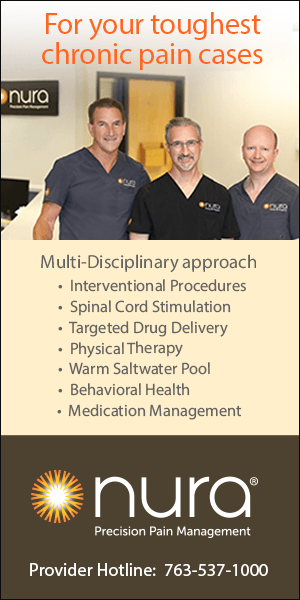arlier this year, Nura Pain Clinics was the first facility in Minnesota to treat patients suffering from symptoms of lumbar spinal stenosis with or without mild to moderate misalignment of the lumbar spine (grade 1 – 2 spondylolisthesis) using the Spinal Simplicity Minuteman™ MIS Fusion Plate. This device was developed by Dr. Harold Hess, MD, a Board Certified Neurosurgeon, who has spent his career creating and performing cutting edge procedures. In May 2011, Spinal Simplicity received CE approval to make the MinuteMan device available to patients in Europe. In January 2015 the MinuteMan G3 device was granted FDA 510(k) clearance for use in the United States. In January 2017 the updated version, HA MinuteMan G3 that incorporates hydroxyapatite to promote bone fusion was also granted FDA 501(k) clearance. To date the device has provided more than 2000 patients worldwide with a minimally invasive solution that delivers long-term relief of leg and back pain. There have been no reports of device failure or serious complications. The procedure is a notable evolution in the treatment of spondylolisthesis and offers several significant benefits compared to other alternatives currently available. Our patient data and testimonials further support the effectiveness of this new procedure.
Pain Management
The MinuteMan
Advances in Spinal Fusion
By R. Scott Stayner, MD, PhD
Indications for Use & Comparative Advantages:
Patients with mild to moderate spondylolisthesis often undergo surgery to decompress and fuse the spine, often called spinal fusion surgery. This is done to correct the underlying anatomical abnormalities that often develop with age such as instability of the lumbar spine (spondylolisthesis) and subsequent narrowing of the spinal canal (spinal stenosis). Spinal fusion surgery requires dissection of muscles and resection of bone to open the narrowed spinal canal. Rods and screws are often placed in the spine for stabilization. A traditional posterior fusion surgery requires 142 minutes of OR time with a blood loss of 290 mL on average. The surgery also requires general anesthesia and a hospital stay of 2.9 days.
Traditional spinal fusion surgery is rigorous so patients with comorbidities such as uncontrolled diabetes, significant heart disease and advanced age are often left untreated out of concern for intraoperative and postoperative complications. Recovery for many patients requires several months of intense physical therapy. Over time, areas of the spine surrounding the fused spinal level also tend to be affected – a phenomenon termed adjacent segment disease (ASD), transitional syndrome or adjacent segment degeneration. This is thought to occur because the fused level is extremely rigid and exerts mechanical stress on the levels above and below. Sometimes a second or even third surgery is required years after the initial surgery to treat recurrent symptoms due to degeneration of the adjoining levels.
The Minuteman device® is a minimally invasive, interspinous-interlaminar fusion device FDA approved for the fixation and stabilization of a single level in the lumbar spine. This procedure can be performed in under an hour at an outpatient surgery center through a 1-inch incision with less than 20 mL of blood loss. The patient goes home the same day and is usually able to resume activities of daily living within 24 hours. Additionally, the spine stabilizing muscles, bones and ligaments remain intact after the surgery. Even though the device promotes eventual fusion of the unstable level, it allows for micro movement at the adjacent levels which minimizes the risk of adjacent segment disease.
Patients report being able to reduce their use of opioid and other pain medications.
Treatment & Features:
Patients with symptomatic spinal stenosis often report difficulty walking upright due to back and leg pain, weakness, heaviness and/or general discomfort. This is called neurogenic claudication. These symptoms resolve when the patient sits down and rests. Additionally, many patients with lumbar spinal stenosis report the ability to walk with greater ease when they lean forward. The classic finding is that the patient is able to walk much more comfortably when leaning over a shopping cart at the grocery store or when using a walker. This is termed the “shopping cart” sign. The act of leaning forward opens the spinal canal at the narrowed level, which relieves pressure on the crowded nerves in the spinal canal and results in less discomfort while ambulating.
One function of the MinuteMan device is to prop open the spinal canal at the unstable and narrowed level. This allows the patient to walk upright with greater comfort but does not affect overall posture. The device is placed between the two spinous processes at the narrowed spinal level. Two plates flank the spinous processes at the strongest, most ventral point. A central screw is used to bring the plates close together so that they adhere tightly to the upper and lower spinous processes. This opens the narrowed spinal segment while stabilizing the spine.
Additionally, the MinuteMan device is designed to fuse the spine at the affected level. Prior to implantation, hydroxyapatite is deposited in the window engineered into the center post screw. Over time, the hydroxyapatite promotes bony fusion that further stabilizes the unstable level.
The procedure is performed on an outpatient basis under “twilight sedation” with Monitored Anesthesia Care (MAC). Patients generally recover within 45 minutes and are discharged home. Patients can resume activities of daily living within 24 hours of the surgery. An 8-week course of weekly or twice a week physical therapy is recommended to help patients recondition the paraspinal muscles that have been weakened by years of hunched posture. The MinuteMan device is designed to remain permanently in the spine but can be easily excised by a spinal surgeon if a more invasive fusion surgery is deemed necessary in the future.
An on-going study of patients who were treated with the MinuteMan device for lumbar spinal stenosis showed long term results in pain and function. Most impressive was that patients reported an 80% reduction VAS score for leg pain 12 months after implantation. Back pain VAS was 50% compared to baseline pain scores. Oswestry Disability Index, a measure of function, improved by 50% at 12 months compared to baseline scores.
There are additional economic benefits for this procedure compared to traditional spinal decompression and fusion surgery. The average cost of a traditional spinal fusion surgery in Minnesota is $36,433. Much of this cost is due to the increased length of surgery and the need for at least one overnight stay in the hospital. This does not reflect additional costs such as extensive physical therapy and rehabilitation, extended nursing care for elderly patients or time off work for younger patients. The MinuteMan device costs roughly $20,000 in the outpatient setting, does not require an overnight hospital stay and patients are able to resume activities of daily living within 24 hours of surgery. Minimum post-operative pain medication is needed after the procedure due to the small incision and shortened surgery time.
This procedure can be performed in under an hour.
Summary
Compared to traditional open spinal decompression and fusion surgery, treating mild spondylolisthesis with associated lumbar spinal stenosis using the MinuteMan device has many advantages for the right patient. Advantages include:
- Reduced surgery time (35 minutes compared to 142 minutes for posterior fusion surgery)
- No overnight hospital stay
- No general anesthesia required
- Minimal post-op pain
- Return to activities of daily living within 24 hours
- Decreased blood loss (less than 20 mL compared to 290 mL on average for posterior fusion surgery)
- Minimally invasive (1-inch incision)
- Spine stabilizing structures such as the supraspinous ligament, paraspinal muscles and bones are spared and remain intact
- Reduced risk of adjacent segment disease (degeneration of levels below and above the treated level)
- Safer for patients with comorbid diagnoses who cannot tolerate traditional open spine surgery (obesity, diabetes, older age, osteoporosis)
- Alternative option for patients with clinical symptoms of lumbar spinal stenosis that either do not want to undergo the traditional invasive lumbar decompression fusion surgery or have mild radiographic findings that make the more invasive surgery less necessary
- Reduced cost compared to traditional spinal fusion surgery.
Immediate Relief
We have performed approximately 20 Minuteman procedures since mid-January 2021. Most patients comment that walking upright is much more comfortable within 20 minutes after completing the surgery. Leg symptoms tend to resolve completely after device placement. One patient has even scheduled a removal of her spinal cord stimulator because her relief after placing the MinuteMan device has been so profound.
Many patients report being able to reduce their use of opioid and other pain medications after the procedure. The most profound pain relief observed is pain or discomfort associated with walking in an upright position. Most patients also note a reduction in back pain. However, many of our patients have multiple pain generators contributing to low back and leg pain. We have observed that after we correct underlying spinal stenosis and instability with the MinuteMan device, other neuromodulation therapies such as spinal cord stimulation are more effective.
Patient Selection:
Patients who demonstrate clinical signs of lumbar spinal stenosis such as neurogenic claudication (i.e., increased back and leg discomfort when walking upright that is relieved by resting and/or hunching forward) are ideal candidates for treatment with the MinuteMan fusion device. Radiographic findings on lumbar MRI or CT scan of central stenosis or lateral recess and foraminal stenosis at a single level are obtained to determine the spinal level to treat. Flexion/extension X-ray studies are also needed to ensure that the patient does not have more than Grade 2 spondylolisthesis and to determine if the spinous processes at the treatment level are adequately sized.
Currently, the MinuteMan device is on formulary with Medicare and most Medicare Advantage plans. Elderly patients, especially those with symptomatic spinal stenosis, are often ideal candidates for the MinuteMan fusion device since spine surgeons are hesitant to recommend open fusion to correct lumbar spinal stenosis due to increased risk of postoperative complications. Until recently, the only interventional treatment options for such non-operative patients with spondylolisthesis and spinal stenosis have been injections and potentially spinal cord stimulation or targeted drug delivery. The MinuteMan fusion device offers the opportunity to correct the underlying anatomical problem for these patients via a minimally invasive, outpatient surgery. If other treatments, such as spinal cord stimulation or targeted drug delivery are needed to treat irreversible neuropathic pain after placing the MinuteMan fusion device, they are likely to be more successful.
Younger patients with mild to moderate lumbar spondylolisthesis can also benefit from the MinuteMan fusion device. Such patients often have fewer lumbosacral issues. Therefore treating lumbar spinal stenosis with this minimally invasive technique can result in profound changes in function and pain. Coverage for this treatment for non-Medicare plans is expanding as well.
R. Scott Stayner, MD, PhD,
is the Medical Director of Nura Ambulatory Surgery Centers. He is board certified in anesthesiology and pain management. He completed his anesthesiology residency at the University of Minnesota, his Fellowship in Pain Management with the University of California, Davis, and is a graduate of the University of Minnesota Medical School. He earned a PhD in Bioengineering from the University of Utah.
MORE STORIES IN THIS ISSUE
















